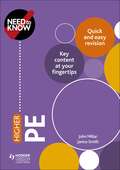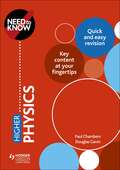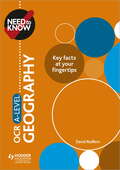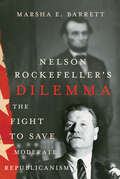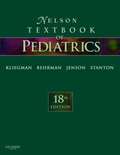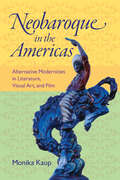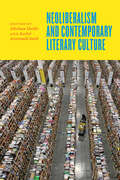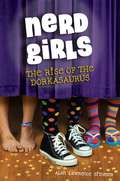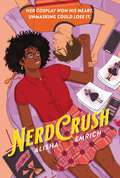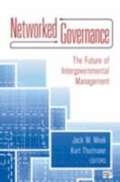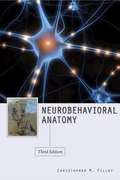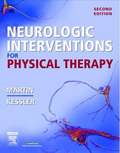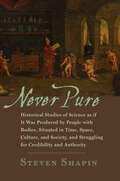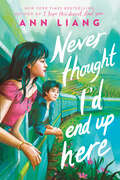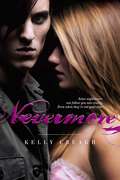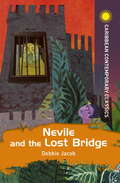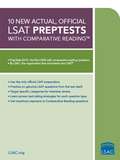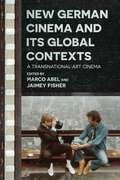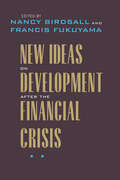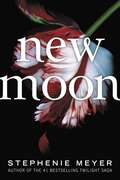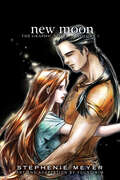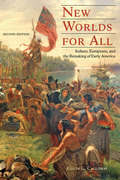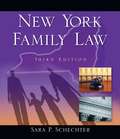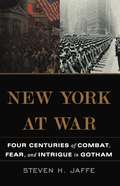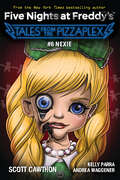- Table View
- List View
Need to Know: Higher PE
by John Millar Janice SmithExam board: SQALevel: HigherSubject: PEFirst teaching: September 2018First exams: Summer 2019 What do you really need to know for the SQA Higher PE exam?This revision guide covers the essentials in less than 100 pages, so it's perfect for early exam preparation or last-minute revision.- Find key content at your fingertips with quick summaries of the factors, concepts and terminology that you need to understand- Get a better grade in your exam with tips on exam technique, mistakes to avoid and important things to remember- Revise and practise using end-of-topic questions and in-depth questions at the end of each section - with answers provided online - Benefit from the knowledge of experienced teachers and examiners John Millar and Janice Smith
Need to Know: Higher Physics Epub
by Paul Chambers Douglas GavinExam board: SQALevel: HigherSubject: PhysicsFirst teaching: September 2018First exams: Summer 2019What do you really need to know for the SQA Higher Physics exam?This revision guide covers the essentials in less than 100 pages, so it's perfect for early exam preparation or last-minute revision.- Find key content at your fingertips with quick summaries of the concepts, issues and terminology that you need to understand- Get a better grade in your exam with tips on exam technique, mistakes to avoid and important things to remember- Revise and practise using end-of-topic questions and in-depth questions at the end of each section - with answers provided online
Need to Know: Ocr A-level Geography Epub
by David RedfernExam board: OCRLevel: A-levelSubject: GeographyFirst teaching: September 2016First exams: Summer 2017 (AS); Summer 2018 (A-level)Find what you need to know, when you need it, with key facts at your fingertips for OCR A-level Geography.Keep this course companion by your side throughout your A-levels so you can check content, review your understanding, use quick tips for success and improve your exam performance.Written by an experienced teacher, author and former senior examiner, this book will help you to:- Build on your learning throughout the course by reinforcing the key facts, terms and concepts from the OCR A-level Geography specification- Answer exam questions more effectively with tips on exam technique, mistakes to avoid and important things to remember- Revise with confidence using 'Do you know?' questions at the end of each topic and more in-depth questions at the end of each sectionThis book covers the following topics:Physical systems- Landscape Systems - Option A: Coastal Landscapes- Earth's Life Support SystemsHuman interactions- Changing Spaces; Making Places- Global Connections - Global Systems Option B: Global Migration- Global Connections - Global Governance Option D: Power and Borders Geographical debates- Disease Dilemmas- Hazardous Earth
Nelson Rockefeller's Dilemma: The Fight to Save Moderate Republicanism
by Marsha E. BarrettNelson Rockefeller's Dilemma reveals the fascinating and influential political career of the four-time New York State governor and US vice president. Marsha E. Barrett's portrayal of this multi-faceted political player focuses on the eclipse of moderate Republicanism and the betrayal of deeply held principles for political power. Although never able to win his party's presidential nomination, Rockefeller's tenure as governor was notable for typically liberal policies: infrastructure projects, expanding the state's university system, and investing in local services and the social safety net. As the Civil Rights movement intensified in the early 1960s, Rockefeller envisioned a Republican Party recommitted to its Lincolnian heritage as a defender of Black equality. But the party's extreme right wing, encouraged by its successful outreach to segregationists before and after the nomination of Barry Goldwater, pushed the party to the right. With his national political ambitions fading by the late 1960s, Rockefeller began to tack right himself on social and racial issues, refusing to endorse efforts to address police brutality, accusing, without proof, Black welfare mothers of cheating the system, or introducing harsh drug laws that disproportionately incarcerated people of color. These betrayals of his own ideals did little to win him the support of the party faithful, and his vice presidency ended in humiliation, rather than the validation of moderate ideals. An in-depth, insightful, and timely political history, Nelson Rockefeller's Dilemma details how the standard-bearer of moderate Republicanism lost the battle for the soul of the Party of Lincoln, leading to mainlining of white-grievance populism for the post-civil rights era.
Nelson Textbook of Pediatrics (18th Edition)
by Richard E. Behrman Robert M. Kliegman Hal B. Jenson Bonita F. StantonThis new and 18th edition attempts to provide the essential information that practitioners, house staff, medical students, and other care providers involved in pediatric health care need to understand to effectively address the enormous range of biologic, psychologic, and social problems that our children and youth may face. Topics covered include genetics, endocrinology, etiology, epidemiology, pathology, pathophysiology, treatment, and prognosis.
Neobaroque in the Americas: Alternative Modernities in Literature, Visual Art, and Film (New World Studies)
by Monika KaupIn a comparative and interdisciplinary analysis of modern and postmodern literature, film, art, and visual culture, Monika Kaup examines the twentieth century's recovery of the baroque within a hemispheric framework embracing North America, Latin America, and U.S. Latino/a culture. As "neobaroque" comes to the forefront of New World studies, attention to transcultural dynamics is overturning the traditional scholarship that confined the baroque to a specific period, class, and ideology in the seventeenth century. Reflecting on the rich, nonlinear genealogy of baroque expression, Neobaroque in the Americas envisions the baroque as an anti-proprietary expression that brings together seemingly disparate writers and artists and contributes to the new studies in global modernity.
Neoliberalism and Contemporary Literary Culture
by Mitchum Huehls; Rachel Greenwald SmithHow has the pervasive spread of free market thinking affected contemporary literature?Neoliberalism has been a buzzword in literary studies for well over a decade, but its meaning remains ambiguous and its salience contentious. In Neoliberalism and Contemporary Literary Culture, Mitchum Huehls and Rachel Greenwald Smith offer a wide-ranging exploration of contemporary literature through the lens of neoliberalism’s economic, social, and cultural ascendance. Bringing together accessible and provocative essays from top literary scholars, this innovative collection examines neoliberalism’s influence on literary theory and methodology, literary form, literary representation, and literary institutions. A four-phase approach to the historical emergence of neoliberalism from the early 1970s to the present helps to clarify the complexity of the relationship between neoliberalism and literary culture. Layering that history over the diverse changes in a US-Anglo literary field that has moved away from postmodern forms and sensibilities, the book argues that many literary developments—including the return to realism, the rise of the memoir, the embrace of New Materialist theory, and the pursuit of aesthetic autonomy—make more coherent sense when viewed in light of neoliberalism’s ever-increasing expansion into the cultural sphere.The essays gathered here engage a diverse range of theorists, including Michel Foucault, Wendy Brown, Giorgio Agamben, Bruno Latour, Maurice Merleau-Ponty, Gary Becker, and Eve Sedgwick to address the reciprocal relationship between neoliberalism and conceptual fields such as biopolitics, affect, phenomenology, ecology, and new materialist ontology. These theoretical perspectives are complemented by innovative readings of contemporary works of literature by writers such as Jennifer Egan, Ben Lerner, Gillian Flynn, Teju Cole, Jonathan Franzen, Chimamanda Ngozi Adichie, Salvador Plascencia, E. L. James, Lisa Robertson, Kenneth Goldsmith, and many others. Neoliberalism and Contemporary Literary Culture is essential reading for anyone invested in the ever-changing state of literary culture.
Nerd Girls: The Rise of the Dorkasaurus (Nerd Girls Ser. #2)
by Alan Lawrence SitomerMaureen, a thirteen-year-old self-proclaimed dork-a-saurus, is totally addicted to cupcakes and hot dogs and thinks that her body looks like a baked potato. Allergy-plagued Alice can't touch a mango without breaking out in a rash, and if she eats wheat, her vision goes blurry. Klutzy to the extreme, Barbara is a beanpole who often embarrasses herself in front of the whole school. These outcasts don't have much in common--other than the fact that they are often targets of the ThreePees: the Pretty, Popular, Perfect girls who rule the school. But one day Maureen discovers that the ThreePees are planning to sit next to Allergy Alice in the cafeteria and eat peanut-butter-and-banana sandwiches on whole wheat toast with mango marmalade for lunch. And Maureen decides that it's time to topple the eight-grade social regime. She joins forces with Alice and Barbara and the Nerd Girls enter the school talent show, determined to take the crown from the ThreePees. Will their routine be enough to de-throne the popular crowd? Or will their plan backfire and shake their hold on the bottom rung of the social ladder?
NerdCrush
by Alisha EmrichHappily Ever Afters meets You've Got Mail in this geeky, Black Girl Magic filled debut romance about cosplay and finding the courage to be yourself. Ramona Lambert is a typical shy, artistic sixteen-year-old. She has a best friend whom she&’s known since they were in diapers; parents who love her; a love for cosplay; and a crush on the cute boy in her class. The only problem? Her best friend moved away; her parents don't quite understand her love of cosplay; and she is pretty sure her crush has no idea she exists. To escape her troubles, Ramona turns to cosplay and her original character, Rel, who gives her the confidence and freedom that she lacks in real life. Embracing this confidence, she decides to strike up an email conversation with her crush, Caleb Wolfe, from her cosplay account in the hopes getting to know him . . . and maybe win his heart. Then as Caleb and Ramona are swept up in their emails back and forth to each other, and Ramona falls even harder as he opens up about his hopes, insecurities, and his own geeky loves. However, as Caleb starts to grow closer and closer to Rel, he also strikes up a friendship with Ramona, who knows she can't keep the truth about Rel from Caleb but isn't sure she is ready to risk losing him. With an important cosplay convention coming up and the anxiety of her double-life weighing on her, Ramona has to decide if she&’ll hide behind her cosplay character forever or take the chance and let Caleb see the real her--because he might actually like her for who she is.
Networked Governance: The Future Of Intergovernmental Management
by Jack W. Meek Kurt ThurmaierIn this unique contributed volume that features chapters written by top scholars paired with practitioner responses, students can see just how much the landscape of intergovernmental relations has evolved in recent years, with diminishing vertical flows of resources, and increased horizontal flows in the form of cross-jurisdictional and interlocal collaboration. Government at all levels must respond to increasing demands in both of these dimensions giving these contributors plenty to say about the future of intergovernmental management in such areas as: #65533; the changing role of managers, #65533; disaster response, #65533; social welfare spending, #65533; cross-boundary management, #65533; regional public-private partnerships, and #65533; sustainable cities. Contributors include Robert Agranoff, J. Edwin Benton, Beverly A. Cigler, Brian K. Collins, Mauricio Covarrubias, Raymond W. Cox II, John Kincaid, Christopher Koliba, William Lester, David Y. Miller, Beryl A. Radin, Juan M. Romero, and Eric S. Zeemering.
Neurobehavioral Anatomy, Third Edition
by Christopher M. FilleyThoroughly revised and updated to reflect key advances in behavioral neurology, Neurobehavioral Anatomy, Third Edition is a clinically based account of the neuroanatomy of human behavior centered on a consideration of behavioral dysfunction caused by disorders of the brain. A concise introduction to brain-behavior relationships that enhances patient care and assists medical students, the book also serves as a handy reference to researchers, neuroscientists, psychiatrists, and geriatricians. The book outlines how cognitive and emotional functions are represented and organized in the brain to produce the behaviors regarded as uniquely human. It reviews the effects of focal and diffuse brain lesions, and from this analysis a conception of the normal operations of the healthy brain emerges. Christopher M. Filley integrates data and material from different disciplines to create a concise and accessible synthesis that informs the clinical understanding of brain-behavior relationships. Clinically practical and theoretically stimulating, the book is an invaluable resource for those involved in the clinical care and study of people with neurobehavioral disorders. Including a useful glossary and extensive references guiding users to further research, the third edition will be of significance to medical students, residents, fellows, practicing physicians, and the general reader interested in neurology.
Neurologic Interventions for Physical Therapy (Second Edition)
by Mary Kessler Suzanne Tink MartinNow completely updated with the latest information on both adult and pediatric patients, this comprehensive book provides a link between the pathophysiology of neurologic deficits and possible rehabilitation interventions for improving movement outcomes. It introduces the structure and function of the nervous system and describes normal motor development, motor control and motor learning, pathophysiology of the nervous system and common treatment techniques used in physical therapy practice. This edition also features updated terminology from the APTA's Guide to Physical Therapist Practice, as well as new chapters on proprioceptive neuromuscular facilitation (PNF) and other neurological conditions seen in the adult. Helpful learning aids and abundant illustrations highlight key concepts and help readers quickly master the material. Helpful learning aids - such as objectives, tables, illustrated intervention boxes, and review questions - reinforce important facts and concepts. Review questions at the end of each chapter allow readers to test their understanding of the material. 700 illustrations clearly depict procedures discussed in the text and clarify descriptions of anatomy, physiology, evaluation, pathology, and treatment. Background information is provided for interventions that can be used in the rehabilitation of adults and children, promoting a complete understanding of techniques. Careful documentation uses current outcomes-based research. Case histories include subjective and objective observation, assessment, planning, and critical decision-making components. Current language of the APTA's Guide to Physical Therapist Practice, 2nd Edition is used throughout, aligning all information with best practices put forth by the APTA. A new chapter on proprioceptive neuromuscular facilitation (PNF) describes how these techniques can be used to improve performance of functional tasks by increasing strength, flexibility, and range of motion.
Never Pure: Historical Studies of Science as if It Was Produced by People with Bodies, Situated in Time, Space, Culture, and Society, and Struggling for Credibility and Authority
by Steven ShapinSteven Shapin argues that science, for all its immense authority and power, is and always has been a human endeavor, subject to human capacities and limits. Put simply, science has never been pure. To be human is to err, and we understand science better when we recognize it as the laborious achievement of fallible, imperfect, and historically situated human beings.Shapin’s essays collected here include reflections on the historical relationships between science and common sense, between science and modernity, and between science and the moral order. They explore the relevance of physical and social settings in the making of scientific knowledge, the methods appropriate to understanding science historically, dietetics as a compelling site for historical inquiry, the identity of those who have made scientific knowledge, and the means by which science has acquired credibility and authority.This wide-ranging and intensely interdisciplinary collection by one of the most distinguished historians and sociologists of science represents some of the leading edges of change in the scholarly understanding of science over the past several decades.
Never Thought I'd End Up Here
by Ann LiangFrom the author of the instant New York Times bestseller I Hope This Doesn't Find You comes another hilarious and romantic romcom, this time following a former model determined to get revenge on the boy who ruined her life.Leah Zhang has just ruined her cousin's wedding. She didn't mean to wish the bride a depressing marriage and poor health, but she's forgotten most of her Mandarin. Her parents stage an intervention: Leah will be sent on a travel program across China's most beautiful cities. To them, it's the perfect opportunity for Leah to get back to her roots. To Leah, it's simply a much-needed escape.But before Leah can even begin to enjoy the luxurious hotels, stunning scenery, and mouth-watering cuisine, she finds that also on the trip is cynical, sarcastic Cyrus Sui, who's somehow only gotten more annoyingly handsome since the day he told a lie that ruined her life. While Leah might be tempted to shove him off the peak of the Yellow Mountain when nobody's looking, she can't get rid of him just yet. After all, she might never get another chance to get revenge.Yet the deeper they wander into China's provinces, the deeper Leah finds herself falling in love - with the boy she once thought she despised, the home she never thought she'd call her own, and the parts of herself she thought were already lost.
Nevermore: A Nevermore Book (The Nevermore Books)
by Kelly CreaghA page-turning psychological mystery that is equal parts horror, humor, and romance, Nevermore is the story of Varen—a Poe fan and Goth—and Isobel—a cheerleader and unlikely heroine. When an English Lit. project pairs the two, Isobel finds herself swept into Varen’s world, one that he has created in his notebook and in his mind, one where the terrifying stories of Edgar Allan Poe come to life. Isobel slowly learns that dreams and words can be much more powerful than she’d ever imagined. As labels of “Goth” and “cheerleader” fade away, Isobel and Varen slip into a consuming romance, braced against the ever-clearer horror that the most chilling realities are those within our own minds. When Isobel has a single chance to rescue Varen from the shadows of his nightmares, will she be able to save him—and herself? Included in this eBook edition of Nevermore, enjoy a free collection of Edgar Allan Poe’s poems and short stories!
Nevile and the Lost Bridge
by Debbie JacobThere have been many great and enduring works of literature by Caribbean authors over the last century. The Caribbean Contemporary Classics collection celebrates these deep and vibrant stories, overflowing with life and acute observations about society.In the year 2222, Neville and his friends Nina and A.T. are elite bridge builders in the province of Aribbea, where children go to work, adults go to school, and everyone is ruled by a tyrannical king. No-one remembers what life was like before the calamitous event which brought the king to power, and enabled him to lock up all secrets and memory in his own library. Aribbeans now have no memory, and no understanding of the world outside the bridges on which they live. When Neville, Nina and A.T. find themselves plunging from a bridge to the land and sea below, they have no idea what will befall them. Sometimes together, sometimes apart, each must make his or her way through the tests and challenges which await them, to find their true place and to begin to recover their history. Accompanied by a varied cast of companions, they encounter Pierre the Bacoo, Papa Bois, the rasta Hunn Dread, Hanuman the monkey and the last dog in Arribea. This motley crew succeeds in posing the first real challenge to his rule which the king has ever faced. What does friendship and loyalty mean? How do we know when we are safe, and what makes us so? Who can we trust?
New Actual, Official LSAT Preptests with Comparative Reading
by Law School Admission CouncilThis essential LSAT preparation tool encompasses PrepTest 52 (the September 2007 LSAT) through PrepTest 61 (the October 2010 LSAT).
New German Cinema and Its Global Contexts: A Transnational Art Cinema (Contemporary Approaches to Film and Media Studies)
by Barry Keith Grant Eric RentschlerRediscovering a momentous cinema movement, its canonization, and its recasting through global discourse. The last of the so-called new waves in film, New German Cinema of the 1970s and early 1980s represents much more than a national phenomenon; it impacted and was influenced by films from around the world. Filmmakers such as the famous troika of Rainer Werner Fassbinder, Werner Herzog, and Wim Wenders, as well as directors, such as Margarethe von Trotta, Helma Sanders-Brahms, and Helke Sander, and Volker Schlöndorff received much critical acclaim both in Germany and abroad. These directors, their films, and their often-infamous reputations constitute one of the most intriguing and consequential legacies of European cinema and world culture. In this groundbreaking view of New German Cinema through a global lens, editors Marco Abel and Jaimey Fisher approach these celebrated years of German art film from diverse and innovative perspectives. Contributors explore these films' transnational circuits of production, distribution, and exhibition, as well as how the films were made and received, thereby inviting us to reexamine the roots of what New German Cinema was and imagine what it might yet become.
New Ideas on Development after the Financial Crisis (Forum on Constructive Capitalism)
by Nancy Birdsall, Francis FukuyamaThe global financial crisis of 2008–9 has changed the way people around the world think about development. The market-friendly, lightly regulated model of capitalism promoted by the United States is now at risk, and development thinking worldwide is at something of an impasse. Editors Nancy Birdsall and Francis Fukuyama bring together leading scholars to explore the implications of the global financial crisis on existing and future development strategies.In addressing this issue, the contributors contemplate three central questions: What effect has the crisis had on current ideas in development thinking? How has it affected and how will it affect economic policy and political realities in Latin America and Asia, including China and India? Will the financial collapse reinforce shifts in geopolitical power and influence, and in what form? Essays answering these questions identify themes that are essential as economic and political leaders address future challenges of development.To help move beyond this time of global economic turmoil, the contributors—the foremost minds in the field of international development—offer innovative ideas about stabilizing the international economy and promoting global development strategies. Contributors: Nancy Birdsall, Center for Global Development; Michael Clemens, Center for Global Development; Kemal Derviş, Brookings Institution; Larry Diamond, Stanford University; Francis Fukuyama, Stanford University; Peter S. Heller, Johns Hopkins University; Yasheng Huang, Massachusetts Institute of Technology; Justin Yifu Lin, World Bank; José Antonio Ocampo, Columbia University; Mitchell A. Orenstein, Johns Hopkins University; Minxin Pei, Claremont McKenna College; Lant Pritchett, Harvard University; Liliana Rojas-Suarez, Center for Global Development; Arvid Subramanian, Johns Hopkins University
New Moon (The Twilight Saga #2)
by Stephenie MeyerFrom evil vampires to a mysterious pack of wolves, new threats of danger and vengeance test Bella and Edward's romance in the second book of the irresistible Twilight saga.For Bella Swan, there is one thing more important than life itself: Edward Cullen. But being in love with a vampire is even more dangerous than Bella could ever have imagined. Edward has already rescued Bella from the clutches of one evil vampire, but now, as their daring relationship threatens all that is near and dear to them, they realize their troubles may be just beginning.Bella and Edward face a devastating separation, the mysterious appearance of dangerous wolves roaming the forest in Forks, a terrifying threat of revenge from a female vampire and a deliciously sinister encounter with Italy's reigning royal family of vampires, the Volturi.Passionate, riveting, and full of surprising twists and turns, this vampire love saga is well on its way to literary immortality.It's here! #1 bestselling author Stephenie Meyer makes a triumphant return to the world of Twilight with the highly anticipated companion, Midnight Sun: the iconic love story of Bella and Edward told from the vampire's point of view."People do not want to just read Meyer's books; they want to climb inside them and live there." -- Time"A literary phenomenon." -- The New York Times
New Moon: The Graphic Novel, Vol. 1 (The Twilight Saga #3)
by Stephenie MeyerIn the first installment of New Moon, Bella and Edward find themselves facing new obstacles, including a devastating separation, the mysterious appearance of dangerous wolves roaming the forest in Forks, a terrifying threat of revenge from a female vampire and a deliciously sinister encounter with Italy's reigning royal family of vampires: the Volturi.
New Worlds for All: Indians, Europeans, and the Remaking of Early America (The American Moment)
by Colin G. CallowayThe interactions between Indians and Europeans changed America—and both cultures.Although many Americans consider the establishment of the colonies as the birth of this country, in fact early America existed long before the arrival of the Europeans. From coast to coast, Native Americans had created enduring cultures, and the subsequent European invasion remade much of the land and society. In New Worlds for All, Colin G. Calloway explores the unique and vibrant new cultures that Indians and Europeans forged together in early America. The journey toward this hybrid society kept Europeans' and Indians' lives tightly entwined: living, working, worshiping, traveling, and trading together—as well as fearing, avoiding, despising, and killing one another. In some areas, settlers lived in Indian towns, eating Indian food. In the Mohawk Valley of New York, Europeans tattooed their faces; Indians drank tea. A unique American identity emerged.The second edition of New Worlds for All incorporates fifteen years of additional scholarship on Indian-European relations, such as the role of gender, Indian slavery, relationships with African Americans, and new understandings of frontier society.
New York Family Law (3rd Edition)
by Sara P. SchechterThe only legal text to focus specifically on family law in the State of New York, this one-of-a-kind resource covers both matrimonial law--including annulment, separation, divorce, and equitable distribution of marital property--and Family Court proceedings, such as family offenses, child protection, termination of parental rights, and adoption. Drawing on 25 years of experience as a New York Family Court judge, author Sara P. Schechter provides a detailed overview of state-specific procedures, substantive law, and terminology, as well as relevant federal legislation and family law issues of national importance. This proven guide combines in-depth content with an engaging, reader-friendly style and abundant features to support learning. Examples include Basics Boxes introducing varieties of family law litigation, Practice Tips to help students apply what they learn, cases and examples to illustrate the real-world relevance of key concepts, and current New York legal forms. Now thoroughly revised and updated to reflect current law and legal issues in the state--including key developments in same-sex marriage legislation, child support law, no-fault divorce law, and child protective laws--NEW YORK FAMILY LAW, Third Edition, is an ideal resource to prepare paralegal and undergraduate legal students for success in the exciting field of family law.
New York at War: Four Centuries of Combat, Fear, and Intrigue in Gotham
by Steven H. JaffeIn New York at War, historian Steven H. Jaffe offers an alternative history of New York City-arguably the most powerful and yet also the most vulnerable city on earth, and a place whose landscape, culture, and inhabitants have been shaped by violence near and far. The threats of war to New York have not always been direct, but even distant wars have had an important influence on the city. Beginning with an Indian attack on one of Henry Hudson’s crewmen (who in 1609 became the first recorded fatality of an act of war in the region’s history), Jaffe describes, in turn, each of the city’s encounters with war over the past four centuries. He recounts the threats Dutch settlers faced from Indians (and each other) after the West India Company established New Amsterdam in 1624; the British encroachment and eventual invasion that transformed the Dutch town into an English colony in 1664; the colonial wars (such as Queen Anne’s War and the French and Indian Wars) that affected the city over the next hundred years; and the divisions and depredations New York endured during the Revolutionary War. The city soon experienced new threats (and became a major naval stronghold) during the Quasi-War with France and the War of 1812, which is now viewed as a second war of independence. The nation’s newfound freedom did nothing to shield New York from the global conflicts that followed the Revolutionary War; in fact, New Yorkers’ sense of vulnerability persisted-and in many ways worsened-in the 19th and 20th centuries. Jaffe shows how New York became hugely powerful as the Union’s "money city” during the Civil War, but nevertheless retained strong economic and emotional ties to the South, and was so wracked by draft riots in 1863 that people suspected a Confederate plot was behind the violence. Many African-American New Yorkers were killed during the riots, highlighting the prejudice that has frequently characterized New York when the city’s inhabitants feel threatened. Fear and prejudice have been bedfellows throughout New York’s history, says Jaffe-and the 1863 draft riots are hardly the only example of this sorry fact. During the build-up to World War I and the war itself, German-Americans were the subject of intense suspicion, which seemed to be confirmed by the discovery of several bombs planted by German saboteurs; one successful attack destroyed an ammunition depot in Jersey City and shattered thousands of windows in Manhattan. (Had New Yorkers learned of the Kaiser’s unrealized plans to invade the city after a massive amphibious landing on Cape Cod, the consequences for German New Yorkers would likely have been fare more dire. ) New Yorkers of German, Japanese, Italian, and Jewish heritage encountered their fair share of hostility during World War II, and in the atomic era that followed the city endured attacks by terrorist groups such as the Weathermen, disaffected Bay of Pigs veterans, Puerto Rican nationalists, and Islamic fundamentalists. Each new assault has seen New Yorkers heap discrimination upon neighbors they perceive as being similar to the attackers. The challenge throughout the city’s history, says Jaffe, has been to distinguish spies, saboteurs, and terrorists from their seemingly identical but innocent neighbors-a difficult task, to be sure, but one whose complexity does not exempt New Yorkers or other Americans from the need to try. Stretching from the colonial era to 9/11 and beyond, New York at War is that most rare of books: a work of history that is at once local and international, timely and timeless. Bringing a unique lens to bear on the world’s most celebrated and contested city, Jaffe reveals the unimaginable ways the city has changed-and how it has stubbornly endured-under threats both external and internal.
Nexie: An AFK Book (Five Nights At Freddy's)
by Kelly Parra Scott Cawthon Andrea WaggenerFive Nights at Freddy's fans won't want to miss this collection of three chilling stories that will haunt even the bravest player...Can you keep a secret? . . . Astrid doesn’t tell anyone about the strange things her Buddytronic doll has been up to. Kara convinces a Pizzaplex employee no one will know if he lets her spend a little more time in the VR attraction. And a Fazbear Entertainment engineer’s custom project has surprises in store for anyone who encounters it. But in the world of Five Nights at Freddy’s, secrets never stay hidden for long . . .In this sixth volume, Five Nights at Freddy's creator Scott Cawthon spins three sinister novella-length tales from uncharted corners of his series' canon. In the world of Five Nights at Freddy's, everything comes with a price to pay.Readers beware: This collection of terrifying tales is enough to rattle even the most hardened Five Nights at Freddy's fans.
